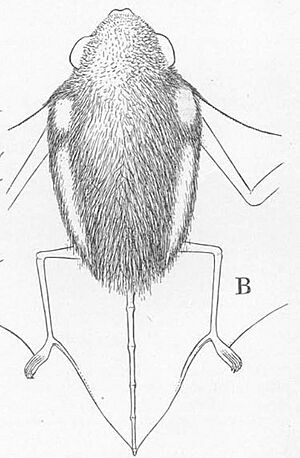Allen's striped bat facts for kids
Quick facts for kids Allen's striped bat |
|
|---|---|
 |
|
| Conservation status | |
| Scientific classification | |
| Genus: |
Glauconycteris
|
| Species: |
alboguttata
|
| Synonyms | |
|
Chalinolobus alboguttatus (J.A. Allen, 1917) |
|
The Allen's striped bat (scientific name: Glauconycteris alboguttata) is a type of bat. It belongs to the family called Vespertilionidae, which are often known as "vesper bats." You can find this bat in parts of Africa, specifically in Cameroon and the Democratic Republic of the Congo. It prefers to live in warm, wet forests found in low-lying areas. We don't know a lot about this particular bat species, making it quite mysterious!
Contents
About the Allen's Striped Bat
Who Discovered This Bat?
This bat was first officially described in 1917 by an American scientist named Joel Asaph Allen. He studied mammals. The very first bat of this species that scientists used to describe it (called a holotype) was collected by two explorers, Herbert Lang and James Chapin. They found it in a place called Medje, in the Democratic Republic of the Congo.
What Does Its Name Mean?
The bat's scientific species name, "alboguttata", comes from two Latin words. "albus" means "white," and "guttate" means "spotted." This name likely refers to the white spots or patches of fur that this bat has on its body.
What Does the Allen's Striped Bat Look Like?
This bat is about 94 mm (3.7 in) long from its head to its tail. That's roughly the length of a credit card! Its forearm, which is part of its wing, is about 41.5 mm (1.63 in) long.
Unlike some other bats, like the Allen's spotted bat, this species has a small spur on its ankle called a calcar. Its fur is a dark brown color, similar to "seal brown." The fur on its back is darker than the fur on its belly.
One of the most interesting features of this bat is its white markings. It has two white patches of fur on each side of its back, making a total of four white spots. There's also a white spot on each shoulder. Plus, a long, thin white stripe runs just below each shoulder spot.
The front part of its wing membrane, called the propatagium, is whitish. The edges of its wings are also white. However, the rest of its flight membranes (the main parts of its wings) and its ears are a dark, blackish-brown color.
Where Does It Live and How Is It Doing?
The Allen's striped bat has been found in Cameroon and the Democratic Republic of the Congo. However, because we don't know much about this species, it's possible it lives in an even larger area than we currently know.
The IUCN (International Union for Conservation of Nature) has evaluated this bat's conservation status. They have listed it as a least concern species. This is the lowest conservation priority, meaning it's not currently considered to be in danger. Even though it's thought to be a rare bat, it lives across a fairly large area, and its total population is probably quite big.


